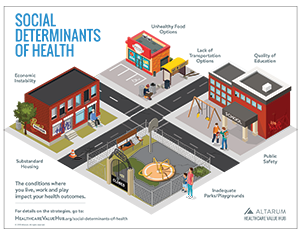Improving Value
Public Health
The foundation of our health begins long before we see doctors or enter the healthcare system for treatment.
Public health is the science of improving and protecting individuals and communities through promotion of healthy lifestyles, research for disease and injury prevention and detection and control of infectious diseases.
Our nation’s public health system operates in large part separately (and often invisibly) from the system that provides most people’s medical care. In general, the health care system cares for patients individually, while public health is about caring for an entire population. Public health includes many things a population takes for granted, like clean air, clean water, effective sanitation, food that is safe to eat, as well as injury prevention, vaccines and other methods of ensuring the control of contagious and environmental diseases.1
It is public health, not advances in medical care, that accounts for most of the increases in life expectancy during the past two centuries.2 |
Public health activities in the United States are funded at the federal, state and local levels. Most public health investments have a significant return on investment (ROI measured in lives saved, diseases and injuries prevented or mitigated, healthcare costs avoided, and improvement in the quality of life. For example, The Trust for America's Health estimates that every $1 spent on community-based health programs—exercise, nutrition, smoking cessation, etc.—leads to a $5.60 return on investment.3
Despite the enormous impact on health and potential cost-savings, just a tiny fraction of overall health spending (3%) is devoted to public health.4 Our nation needs to increase public health spending at the local, state and national levels with a focus on disease prevention, health promotion, health equity, environmental health monitoring, and emergency preparedness. The healthcare savings from these investments must be captured and reinvested in the community, for example, through a public health trust fund.5
Community Infrastructure that Supports Health
The built environment is what is around us as we go about our daily lives. Certain neighborhoods have environments that are more conducive to health living; they have safe, outdoor spaces to exercise, areas for kids to play, and allow community members to walk and not have to depend as much on a car. Infrastructure that supports health includes include targeted urban planning to create green spaces and more walkable mixed residential and commercial areas, as well as supports bus routes and other public transportation options that help move people, in an affordable way, to areas where jobs are located. Tax incentives could be designed to bring grocery stores and healthy food options to areas that might otherwise not have them.
Public Prevention Programs
Prevention is a fundamental element of public health. Prevention includes traditionally thought of public health activities like vaccinations, but also includes broad initiatives to improve the health through interventions designed to prevent chronic diseases. Sin taxes on sugary beverages or on cigarettes could form part of a prevention program to keep people healthier by making unhealthy choices less attractive financially.
Regulatory Action
Regulation can be used to improve public health in several ways. Regulations have created smoke-free areas in offices, restaurants, and public spaces and have made our food and water safer.
Notes
1. Rovner, Julie, Always the Bridesmaid, Public Health Rarely Spotlighted Until It's Too Late, Kaiser Health News (May 4, 2020).
2. Lindsay, Gordon B., Ray M. Merrill and Riley J. Hedin, The Contribution of Public Health and Improved Social Conditions to Increased Life Expectancy: An Analysis of Public Awareness, Journal of Community Medicine & Health Education (October 2014).
3. Blueprint for a Healthier America, 2016: Priorities for the Next Administration and Congress, Trust for America's Health (October 2016).
4.The Impact of Chronic Underfunding on America's Public Health System: Trends, Risks, and Recommendations, 2020, Trust for America's Health (April 2020).







